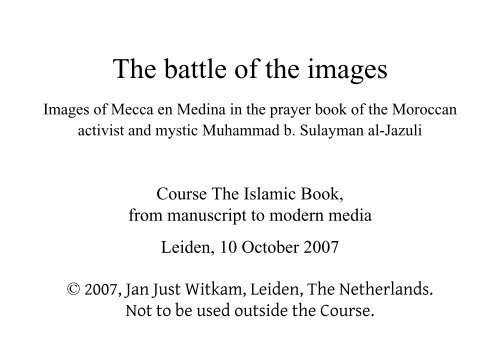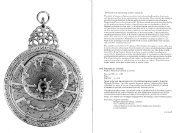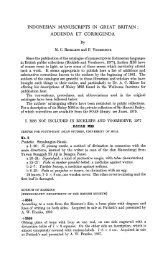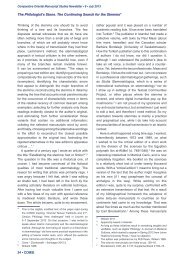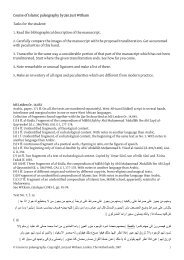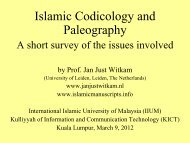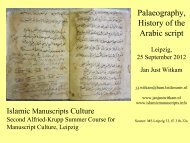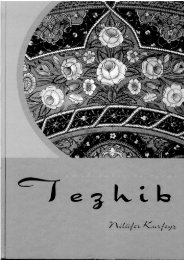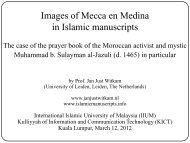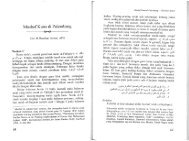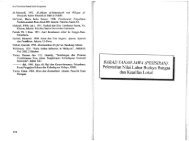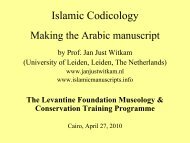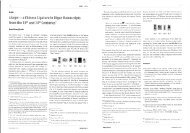Dalá'il al - Islamic manuscripts
Dalá'il al - Islamic manuscripts
Dalá'il al - Islamic manuscripts
Create successful ePaper yourself
Turn your PDF publications into a flip-book with our unique Google optimized e-Paper software.
The battle of the images<br />
Images of Mecca en Medina in the prayer book of the Moroccan<br />
activist and mystic Muhammad b. Sulayman <strong>al</strong>-Jazuli<br />
Course The <strong>Islamic</strong> Book,<br />
from manuscript to modern media<br />
Leiden, 10 October 2007<br />
© 2007, Jan Just Witkam, Leiden, The Netherlands.<br />
Not to be used outside the Course.
Sacred geography.<br />
The Ka’ba in Mecca here<br />
shown as the centre of the<br />
world.<br />
Illustration in a Turkish<br />
manuscript, dated<br />
1060/1650.<br />
Source: MS Leiden, Or. 12.365, f. 90b
Sacred geography.<br />
De Ka’ba in Mecca, seen<br />
from above, as the centre of<br />
the world, with the<br />
orientation for the believers<br />
for their ritu<strong>al</strong> prayer.<br />
The text around contruction<br />
contains the names of<br />
<strong>Islamic</strong> countries, regions<br />
and towns..<br />
Manuscript from Istanbul,<br />
dated 960/1553<br />
Source: MS Leiden, Or. 5, f. 37a
Sacred geography.<br />
The Mosque of the<br />
Prophet Muhammad in<br />
Medina<br />
Under the cupola the<br />
‘Blessed Garden’: the<br />
graves of the prophet and<br />
his first two c<strong>al</strong>iphs, Abu<br />
Bakr and Umar.<br />
Slightly separated:<br />
The grave of Fatima.<br />
At the right: the pulpit<br />
(minbar) of the Prophet.<br />
Source: <strong>al</strong>-Lari, Tuhfat <strong>al</strong>-Haramayn, MS Leiden Or.<br />
11.079, f. 35b (1012/1603).
The Mosque of the Prophet<br />
Muhammad in Medina<br />
The same iconographic<strong>al</strong><br />
elements: cupola, graves,<br />
pulpit, p<strong>al</strong>ms in an open<br />
space.<br />
The space is here filled with<br />
prayer niches.<br />
Painting on paper, as<br />
souvenir for pilgrims,<br />
12th/18th century<br />
Source: Kh<strong>al</strong>ili Collection, Londen, No. 745-2.
The Mosque of the<br />
Prophet Muhammad in<br />
Medina<br />
The same<br />
iconographic<strong>al</strong><br />
elements: cupola,<br />
graves, pulpit, p<strong>al</strong>ms in<br />
an open space.<br />
Visitors’certificate.<br />
Lithography, Medina,<br />
mid-19th century.<br />
Bron: Leiden UB, plano 53 F 1
Graveyard Baqî’ <strong>al</strong>-Gharqad,<br />
outside Medina.<br />
The graves of members of the<br />
family of the Prophet (<strong>al</strong>so of his<br />
favourite wife A’isha) and many<br />
other saints and believers.<br />
It is a place to be buried, or to<br />
visit and ask for intercession<br />
(shafâ’a).<br />
Shortly after the Saudi conquest<br />
of Medina (1925) the graveyard<br />
was destroyed.<br />
Source: <strong>al</strong>-Lari, Tuhfat <strong>al</strong>-Haramayn, MS Leiden Or. 11.079, f. 38b<br />
(1012/1603).
The Mosque of the Prophet<br />
Muhammad in Medina<br />
The same iconographic<strong>al</strong> elements:<br />
cupola, graves, pulpit, p<strong>al</strong>ms in an<br />
open space, but a slightly different<br />
orientation.<br />
From a manuscript from Nat<strong>al</strong>,<br />
West-Sumatra, Indonesia, dated<br />
1229/1814.<br />
Source: Prayer book of Imam Bonjol, MS Leiden Or. 1751,<br />
f. 183a.
Medina and its buri<strong>al</strong> places, here<br />
combined from sever<strong>al</strong><br />
icographic<strong>al</strong> elements.<br />
The p<strong>al</strong>ms of van Fatima (above),<br />
a grill (above), the grave of the<br />
Prophet (centre, below), the<br />
graves of the four righteous<br />
c<strong>al</strong>iphs (left, below). At the right<br />
and the centre graves of the<br />
family of the Prophet and other<br />
saints (orang baik).<br />
From a manuscript from Nat<strong>al</strong>,<br />
West-Sumatra, Indonesia, dated<br />
1229/1814.<br />
Source: Prayer book of Imam Bonjol, MS Leiden Or. 1751,<br />
f. 69b.
Beginning of the text<br />
of the D<strong>al</strong>á’il <strong>al</strong>-<br />
Khayrat, the prayer<br />
book by <strong>al</strong>-Jazûlî.<br />
Here with the title<br />
which is nowadays<br />
current in Morocco:<br />
D<strong>al</strong>íl.<br />
Manuscript from<br />
Morocco, 18th cent.<br />
Source: MS Leiden, Acad. 32, f. 1b.
Title-page of one of the<br />
numerous printed editions<br />
of <strong>al</strong>-Jazûlî’s prayer book<br />
D<strong>al</strong>á’il <strong>al</strong>-Khayrát.<br />
Cairo 1333/1914.<br />
Source: Leiden UB, 830 C 16
Title-page of one of the<br />
numerous printed editions of<br />
<strong>al</strong>-Jazûlî’s prayer book D<strong>al</strong>á’il<br />
<strong>al</strong>-Khayrát.<br />
Cairo 1369/1949<br />
Source: Leiden UB, 8108 D 23
Colophon of one of the<br />
numerous printed editions<br />
of <strong>al</strong>-Jazûlî’s prayer book<br />
D<strong>al</strong>á’il <strong>al</strong>-Khayrát.<br />
Cairo 1354/1935<br />
A lithographic<strong>al</strong> edition<br />
destined for the North<br />
African market.<br />
Source: Leiden UB, 8195 C 17, pt. 2, p. 24
Title-page of one of the<br />
numerous printed editions of<br />
<strong>al</strong>-Jazûlî’s prayer book D<strong>al</strong>á’il<br />
<strong>al</strong>-Khayrát.<br />
Here it is part of a much larger<br />
collection of prayers. With a<br />
translation, and numerous<br />
additions, in Urdu.<br />
Lahore, Pakistan 1405/1985<br />
Source: Leiden UB, 8439 D 6
Cover of one of the<br />
numerous printed editions<br />
of <strong>al</strong>-Jazûlî’s prayer book<br />
D<strong>al</strong>á’il <strong>al</strong>-Khayrát.<br />
Here with a modern Turkish<br />
translation (in Latin script).<br />
Istanbul 1997.<br />
Source: Private collection_
Cover of one of the<br />
numerous printed editions<br />
of <strong>al</strong>-Jazûlî’s prayer book<br />
D<strong>al</strong>á’il <strong>al</strong>-Khayrát.<br />
Here with a corrected<br />
Arabic text.<br />
Kudus (Centr<strong>al</strong> Java) ca.<br />
2000.<br />
Source: Private collection
Title-page of the Turkish<br />
commentary by Kara Davud<br />
of the D<strong>al</strong>á’il <strong>al</strong>-Khayrát.<br />
Istanbul 1975<br />
Source: Leiden UB, 8161 C 22
Title-page of the Urdu<br />
translation of the work<br />
Matáli` <strong>al</strong>-Masarrát, the<br />
authoritative and detailed<br />
commentary by a 17thcentury<br />
follower of <strong>al</strong>-Jazûlî,<br />
Muhammad <strong>al</strong>-Mahdi <strong>al</strong>-<br />
Fásí, on the D<strong>al</strong>á’il <strong>al</strong>-<br />
Khayrát.<br />
Lahore, ca. 2000.<br />
Bron: Particuliere collectie
Interior of the Mosque of Sidi Ben Slimane <strong>al</strong>-Jazûlî in<br />
Marrakech.<br />
Source: Photograph by Ahmed Ben Smaïl, in: Edmond Amran el M<strong>al</strong>eh, Lumière de l’ombre, Rabat 2003.
Collective recit<strong>al</strong> of the D<strong>al</strong>â’il <strong>al</strong>-Khayrât of <strong>al</strong>-Jazûlî, in<br />
the Mosque of Sidi Abû ’l-‘Abbâs <strong>al</strong>-Sabtî, Marrakech<br />
(1997). Source: Photograph by Mariette van Beek, Leiden, No. 2594/26.
Collective recit<strong>al</strong> of the D<strong>al</strong>â’il<br />
<strong>al</strong>-Khayrât of <strong>al</strong>-Jazûlî, in the<br />
Mosque of Sidi Abû ’l-‘Abbâs<br />
<strong>al</strong>-Sabtî, Marrakech (1997).<br />
Source: Photograph by Mariette van Beek, Leiden, No.<br />
2594/23.
Collection Asmâ’ <strong>al</strong>-Nabî,<br />
the names (epitheta) of the<br />
Prophet Muhammad,<br />
followed by eulogies in the<br />
shape of a tasliya.<br />
This type of prayer has<br />
become wide-spread D<strong>al</strong>â’il<br />
<strong>al</strong>-Khayrât of <strong>al</strong>-Jazûlî. The<br />
litany of tasliya is possibly<br />
invented by <strong>al</strong>-Jazûlî.<br />
Manuscript of D<strong>al</strong>â’il <strong>al</strong>-<br />
Khayrât, end 18th century,<br />
from Banten, West Java<br />
Source: MS Leiden Or. 7057a, f. 29b
Modern, separate publication<br />
of Asmâ’ <strong>al</strong>-Nabî, the names<br />
of the Prophet, a booklet from<br />
India.<br />
In the introduction of the<br />
D<strong>al</strong>â’il <strong>al</strong>-Khayrât <strong>al</strong>-Jazûlî<br />
sums up his collection of 201<br />
names, which he has brought<br />
together from holy sources,<br />
the Qur’an and the Tradition.<br />
These names are the basic<br />
materi<strong>al</strong> for the litanies of<br />
which the D<strong>al</strong>â’il <strong>al</strong>-Khayrât<br />
mainly consists.<br />
Source: Private collection
Description of the<br />
grave chamber in the<br />
Mosque of the Prophet<br />
in Medina: the ‘blessed<br />
garden’, Al-Rawda <strong>al</strong>-<br />
Mubaraka.<br />
Manuscript of D<strong>al</strong>á’il<br />
<strong>al</strong>-Khayrat from West<br />
Africa (Mauritania of<br />
Northern Nigeria), 20th<br />
century.<br />
Source: MS Leiden, Or. 25.418, f. 8a
Satchel for the<br />
manuscript of<br />
D<strong>al</strong>á’il <strong>al</strong>-<br />
Khayrat from<br />
West Africa.<br />
(Mauritania of<br />
Northern<br />
Nigeria, 20th<br />
century)<br />
Source: MS Leiden, Or. 25.418
Image of the buri<strong>al</strong> chamber<br />
in the Mosque of the Prophet<br />
in Medina, the blessed<br />
garden, <strong>al</strong>-Rawda <strong>al</strong>-<br />
Mubaraka, with the graves of<br />
the Prophet Muhammad and<br />
the first two c<strong>al</strong>iphs, Abu<br />
Bakr and Umar.<br />
Manuscript of D<strong>al</strong>á’il <strong>al</strong>-<br />
Khayrat from Morocco, 18th<br />
century.<br />
Source: MS Leiden, Or. 23.723, f. 10b.
The buri<strong>al</strong><br />
chamber in the<br />
Mosque of the<br />
Prophet in<br />
Medina, with the<br />
three graves.<br />
Manuscript of<br />
D<strong>al</strong>á’il <strong>al</strong>-<br />
Khayrat from<br />
Morocco, 18th<br />
century.<br />
Bron: MS Leiden, Acad. 33, p. 45.
Al-Rawda <strong>al</strong>-Mubâraka.<br />
The buri<strong>al</strong> chamber in<br />
Medina.<br />
Manuscript of D<strong>al</strong>á’il <strong>al</strong>-<br />
Khayrat, from India,<br />
19th century.<br />
With interlinear<br />
translation Persian.<br />
Source: MS Leiden, 22.958, ff. 23a
Al-Rawda <strong>al</strong>-<br />
Mubâraka.<br />
The buri<strong>al</strong> chamber in<br />
Medina.<br />
Manuscript of D<strong>al</strong>á’il<br />
<strong>al</strong>-Khayrat, from<br />
Banten (West Java),<br />
end 18th century.<br />
Source: MS Leiden, Oe. 7057a, f. 32b.
Al-Rawda <strong>al</strong>-Mubâraka. The buri<strong>al</strong> chamber in Medina.<br />
Miniature manuscript of D<strong>al</strong>á’il <strong>al</strong>-Khayrat, from Sumatra<br />
(Indonesia), 19th century.
Al-Rawda <strong>al</strong>-Sharîfa.<br />
The buri<strong>al</strong> chamber in<br />
Medina.<br />
Moderne edition of the<br />
D<strong>al</strong>á’il <strong>al</strong>-Khayrat,<br />
Casablanca 1418/1997.<br />
Source: Particuliere collectie
Al-Rawda <strong>al</strong>-Sharîfa. The buri<strong>al</strong> chamber in Medina (at right),<br />
and the Minbar (pulpit) of the Prophet Muhammad in the<br />
Prophet’s Mosque in Medina.<br />
Manuscript of D<strong>al</strong>á’il <strong>al</strong>-Khayrat from Morocco, 18th century.<br />
Source: MS Leiden, Acad. 32, ff. 22b-23a.
Guide for the pilgrimage.<br />
The manuscript once<br />
belonged to the Mamluksultan<br />
Chaqmaq (reigned:<br />
842-857/1438-1453).<br />
Description of the Mawqif<br />
<strong>al</strong>-Nabî, de ‘position of the<br />
Prophet’, between the grave<br />
and the pulpit in the<br />
Mosque of Medina. This<br />
Mawqif is described as one<br />
of the gardens of paradise.<br />
Source: MS Leiden, Or. 458, p. 133.
(Fiction<strong>al</strong>) portrait of<br />
Ludovico di Varthema,<br />
an It<strong>al</strong>ian traveller who<br />
visited, in 1503, Medina<br />
(and <strong>al</strong>so Mecca).<br />
He too mentions the<br />
existence of the grave of<br />
Jesus in the grave<br />
chamber of Medina.<br />
Title-page of a Dutch<br />
translation of his<br />
travelogue, Utrecht 1654.<br />
Source: Leiden UB 352 C 25
Al-Rawda <strong>al</strong>-Sharîfa. The buri<strong>al</strong> chamber in Medina (at<br />
right), and the Minbar (pulpit) of the Prophet Muhammad in<br />
the Prophet’s Mosque in Medina.<br />
Manuscript of D<strong>al</strong>á’il <strong>al</strong>-Khayrat from Morocco, 19th<br />
century.<br />
Source: MS Leiden, Or. 23.263, ff. 21b-22a.
Al-Rawda <strong>al</strong>-Sharîfa. The buri<strong>al</strong> chamber in Medina (at right), and<br />
the Minbar (pulpit) of the Prophet Muhammad in the Prophet’s<br />
Mosque in Medina. Manuscript of D<strong>al</strong>á’il <strong>al</strong>-Khayrat from Egypt,<br />
18th century.<br />
Source: MS Leiden, Or. 11.065, ff. 15b-16a.
Al-Rawda <strong>al</strong>-Sharîfa. The buri<strong>al</strong> chamber in Medina (at left), and<br />
the Minbar (pulpit) of the Prophet Muhammad in the Prophet’s<br />
Mosque in Medina. Manuscript of D<strong>al</strong>á’il <strong>al</strong>-Khayrat from Egypt,<br />
19th century. Illustration made from pasted strips of coloured paper.<br />
Source: MS Leiden, Or. 14.462, ff. 16b-17a.
Al-Rawda <strong>al</strong>-Sharîfa. The buri<strong>al</strong> chamber in Medina Manuscript<br />
and lithography of D<strong>al</strong>á’il <strong>al</strong>-Khayrat from Istanbul, 1275/1858.<br />
Source: MS Leiden, Or. 12.016, pp. 104-105.
Combined miniature of Al-Rawda <strong>al</strong>-Mubâraka (left) and the<br />
Minbar, the pulpit of the Prophet in the Mosque of Medina.<br />
Manuscript from Centr<strong>al</strong> Asia, late-19th century.<br />
Source: MS private collection
Miniature of Al-Rawda <strong>al</strong>-Mubâraka (right) and the Minbar, the<br />
pulpit of the Prophet in the Mosque of Medina. Manuscript from<br />
South-East Asia, probably 19th century.<br />
Source: MS Ku<strong>al</strong>a Lumpur, Nation<strong>al</strong> Library of M<strong>al</strong>aysia, No. 1273.
The mosques of Mecca (right) and of Medina.<br />
Miniature in a manuscript of the D<strong>al</strong>â’il <strong>al</strong>-Khayrât, from Nat<strong>al</strong><br />
(West Sumatra), dated 1229/1814.<br />
Prayer book of the famous Imâm of Bonjol.Source: MS Leiden, Or. 1751, ff. 68b-69a.
The Great Mosque in Mecca.<br />
Image made as a souvenir for<br />
a pilgrim.<br />
Source: Kh<strong>al</strong>il Collection, Londen.
The Great Mosque in<br />
Mecca.<br />
Image made as a souvenir<br />
for a pilgrim.<br />
Iznik tiles, middle of the<br />
16th century<br />
Source: Athene, Benaki Museum
The Great Mosque in Mecca.<br />
Illustration in <strong>al</strong>-Nahrâwâli,<br />
<strong>al</strong>-I`lâm bi-A`lâm Bayt Allâh<br />
<strong>al</strong>-Harâm.<br />
Manuscript from Istanbul,<br />
dated 1005/1596<br />
Source: MS Leiden, Or. 832, f. 88b
The mosques of Mecca (right) and of Medina.<br />
Miniature in a manuscript of the D<strong>al</strong>â’il <strong>al</strong>-Khayrât, from Istanbul<br />
1254/1838. A luxury book.<br />
Bron: MS Leiden, Or. 12.455, ff. 15b-16a.
The mosques of Mecca (right) and of Medina.<br />
Miniature in a manuscript of the D<strong>al</strong>â’il <strong>al</strong>-Khayrât, possibly from<br />
Kashmir or Gujerat. 19th century.<br />
Source: MS Leiden, Or. 14.276, ff. 70b-71a.
The mosques of Mecca (right) and of Medina.<br />
Miniature in a manuscript of the D<strong>al</strong>â’il <strong>al</strong>-Khayrât, possibly from<br />
India.<br />
Source: MS Leiden, Or. 22.963, ff. 18b-19a.
The mosques of Mecca (right) and of<br />
Medina.<br />
Illustrations in a recent reprint (Ankara<br />
1421/2000) of a lithographic<strong>al</strong> edition<br />
of the D<strong>al</strong>â’il <strong>al</strong>-Khayrât (Istanbul,<br />
mid-19th century). Source: Private collection.
The mosques of Mecca (right) and of Medina.<br />
Illustration to Sharaf <strong>al</strong>-Anâm, an Indonesian Arabic poem.<br />
From Kudus (Centr<strong>al</strong> Java) ca. 2000.<br />
Source: Private collection..


